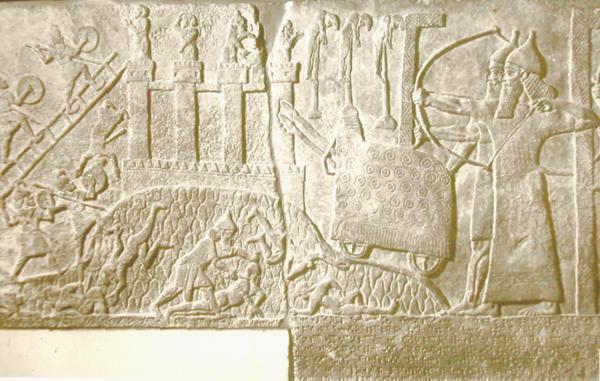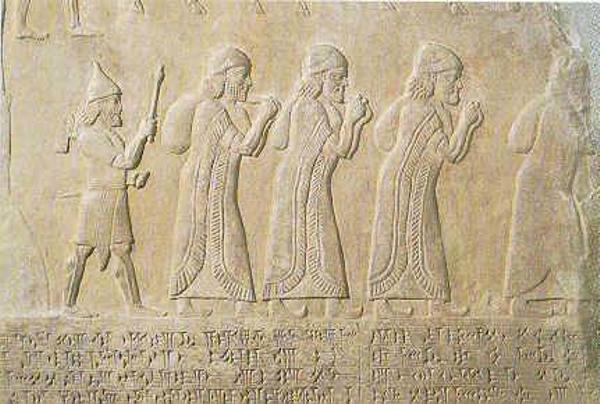





As was the custom of Assyrian kings, Tiglath-Pileser III inscribed his annals in word and picture on stone slabs that lined the palace walls. In the closeup of the example above, the cuneiform inscription of the text of the annals can be seen. The location of the battle scene is not known for sure. The prisoners in the lower scene are believed to be from the city of Astartu in Jordan.
From Tiglath-pileser III (744-727) Building Inscription: Campaigns against Syria and Palestine. Year Unknown. From a fragmentary annalistic text published by Rawlinson, Vol. III, Pl. 10, No. 2, 1-45; Rost, Pls. XXVXXVI, text, pp. 79-83. Translation: Luckenbill, AR, I, §§815-819; cf. also E. Forrer, Provinzeinteilung, pp. 59 f.
...the town Hatarikka as far as the mountain Saua, [...the towns;] Byb[los],...Simirra, Arqa, Zimarra,...Uznu, [Siannu], Ri'-raba, Ri'sisu,... the towns of the Upper Sea, I brought under my rule. six officers of mine I installed as governors over them. [...the town R]ashpuna which is (situated) at the coast of the Upper Sea, [the towns...]nite, Gal'za, Abilakka which are adjacent to Israel (Bît Hu-um-ri-a) [and the] wide (land of) [Naphta]li, in its entire extent, I united with Assyria. Officers of mine I installed as governors upon them..
As to Hanno of Gaza (Ha-a-nu-ú-nu alHa-az-za-at-a-a) who had fled before my army and run away to Egypt, [I conquered] the town of Gaza,...his personal property, his images...[and I placed (?)] (the images of) my [...gods] and my royal image in his own palace and declared (them) to be (thenceforward) the gods of their country. I imposed upon th[em tribute]. [As for Menahem I ov]erwhelmed him [like a snowstorm] and he fled like a bird, alone, [and bowed to my feet(?)]. I returned him to his place [and imposed tribute upon him, to wit:] gold, silver, linen garments with multicolored trimmings,...great...[I re]ceived from him. Israel (lit.: "Omri-Land" Bît Humria)...all its inhabitants (and) their king Pekah (Pa-qa-ha) and I placed Hoshea (A-ú-si-') as king over them. I received from them 10 talents of gold, 1,000(?) talents of silver as their [tri]bute and brought them to Assyria.
As for Samsi, queen of Arabia,...I killed, 1,100 inhabitants, 30,000 camels, 20,000 (heads of) cattle[...] 5,000 (containers with all kinds of spices, 11 tûlu -bowls, the property of her gods,...her (own) possessions, I took away from her and she herself [fled] to save her life to the town of Bazu, a waterless region (lit.: a place of thirst) like a wild donkey-mare...forced by hunger, the people which were in her camp [did]...(Then) she became apprehensive [of the power of] my strong [army] and brought to me male and female camels,...her....[I put a regent over her. I made the Bir'ai bow to my feet.] The inhabitants of Mas'ai, Tema, the Sabaeans, the inhabitants of Haiappa, Badana, Hattia, the Idiba'leans, ...from the region of the West [whose far] away countries [nobody knows, heard] of the fame of my rule [and]...they bowed to the yoke of my rule. [They brought to me]--without exception--as their tribute male and female camels and all kinds of spices and kissed my feet...I appointed Idibi'lu to the office of Warden of marches on (the frontier of) Musur (Mu-su-ri).